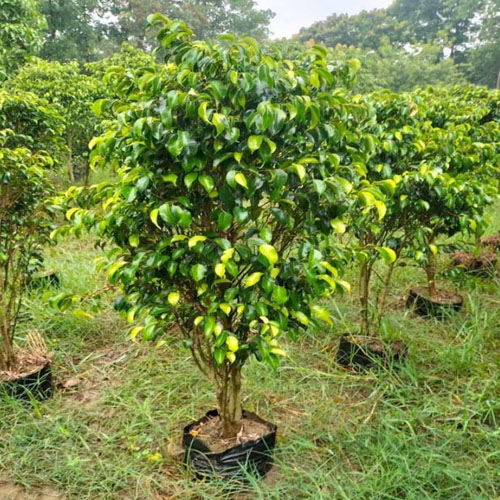Black Ficus Plants
Black Ficus plants are often referred to as Ficus elastica or Ficus lyrata, known for their dark, glossy foliage. Here's an overview of these popular Ficus varieties:
1. Rubber Plant (Ficus elastica)
-
Scientific Name: Ficus elastica
-
Common Names: Rubber Plant, Rubber Tree, Black Rubber Plant
-
Description:
- Features large, shiny, dark green to nearly black leaves. The leaves can be broad and leathery, with a glossy surface.
- Can grow up to 10-12 feet (3-4 meters) tall indoors and even taller in its native tropical habitat.
- The plant has a sturdy, upright growth habit and can be grown as a single trunk or in a bushier, multi-stem form.
-
Origin: Native to India and Malaysia.
-
Growing Conditions:
- Light: Prefers bright, indirect light but can tolerate lower light conditions. Avoid direct sunlight, which can scorch the leaves.
- Water: Water when the top inch of soil feels dry. Overwatering can lead to root rot, so ensure proper drainage.
- Temperature: Thrives in temperatures between 15-25°C (59-77°F). Protect from drafts and temperatures below 10°C (50°F).
- Humidity: Prefers moderate humidity. It can tolerate lower humidity levels but may benefit from occasional misting.
-
Care Tips:
- Fertilization: Feed with a balanced liquid fertilizer every 4-6 weeks during the growing season (spring and summer). Reduce feeding in the fall and winter.
- Pruning: Prune to maintain shape and remove any dead or damaged leaves. The plant can also be trimmed to control its size.
- Pests and Diseases: Watch for pests like spider mites, scale, and mealybugs. Clean the leaves regularly to help prevent dust accumulation and pest issues.
2. Fiddle Leaf Fig (Ficus lyrata)
-
Scientific Name: Ficus lyrata
-
Common Names: Fiddle Leaf Fig, Fiddle Leaf Tree
-
Description:
- Known for its large, leathery, violin-shaped leaves that can be deep green to almost black. The foliage is very dramatic and makes a bold statement.
- Grows to about 6-10 feet (2-3 meters) tall indoors and can develop a tree-like structure with proper care.
-
Origin: Native to West Africa.
-
Growing Conditions:
- Light: Prefers bright, indirect light but can tolerate some direct sunlight. Adequate light helps maintain its vibrant foliage.
- Water: Water when the top 1-2 inches of soil are dry. The plant prefers well-draining soil and should not be overwatered.
- Temperature: Thrives in temperatures between 18-24°C (65-75°F). Protect from drafts and sudden temperature changes.
- Humidity: Enjoys higher humidity but can adapt to average indoor conditions.
-
Care Tips:
- Fertilization: Feed with a balanced fertilizer once a month during the growing season (spring and summer). Reduce feeding during the winter months.
- Pruning: Prune to control the shape and size of the plant, as well as to remove any damaged or dead leaves.
- Pests and Diseases: Check for pests like spider mites and aphids. Clean the leaves regularly and ensure good air circulation to prevent fungal issues.
Both Ficus elastica and Ficus lyrata are popular for their striking foliage and relatively easy care, making them great choices for indoor plant enthusiasts. If you have a specific type of Ficus or another plant in mind, let me know!


